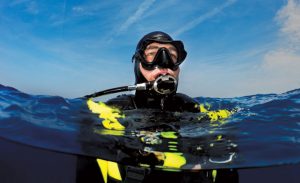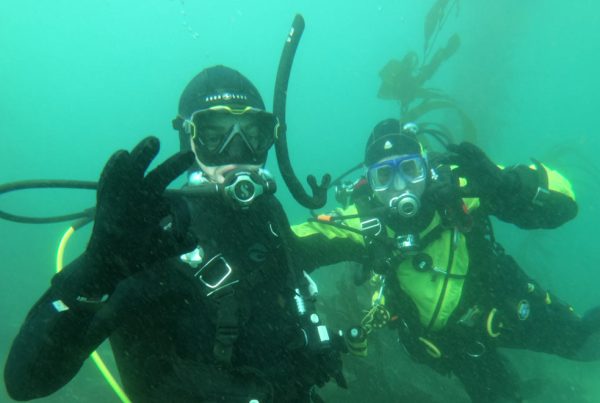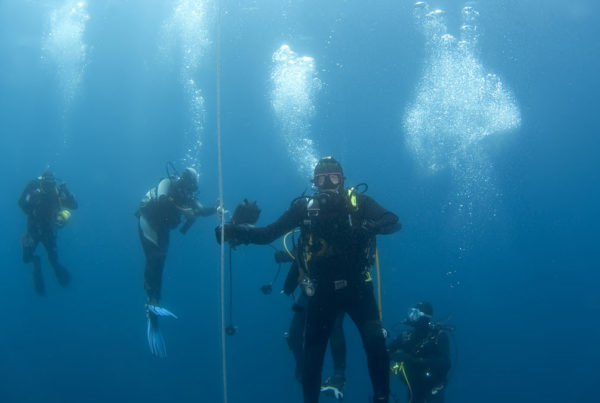 The rich California coastline offers a bounty of marine life and a range of dive locations to suit every diver. We’ve got kelp beds, rocky reefs and wrecks. We’ve got offshore islands reachable only by boat, and we’ve got some spectacular shore diving, too. We can hunt and collect our dinner, or capture stunning images with a camera. In other words, we’ve got options. When it comes to equipping ourselves with the proper exposure protection needed for safely and comfortably exploring our decidedly temperate waters, we’re lucky that we’ve got plenty of options in that area, too. Even though California is sunny and warm our waters aren’t. But that’s no reason for any diver to complain, “It’s too cold to dive here.” We’re calling baloney on that kind of talk. All you need to do is select thermal protection that supports your personal needs, the conditions and your diving style, and you’ll be comfortable — and happy in the water.
The rich California coastline offers a bounty of marine life and a range of dive locations to suit every diver. We’ve got kelp beds, rocky reefs and wrecks. We’ve got offshore islands reachable only by boat, and we’ve got some spectacular shore diving, too. We can hunt and collect our dinner, or capture stunning images with a camera. In other words, we’ve got options. When it comes to equipping ourselves with the proper exposure protection needed for safely and comfortably exploring our decidedly temperate waters, we’re lucky that we’ve got plenty of options in that area, too. Even though California is sunny and warm our waters aren’t. But that’s no reason for any diver to complain, “It’s too cold to dive here.” We’re calling baloney on that kind of talk. All you need to do is select thermal protection that supports your personal needs, the conditions and your diving style, and you’ll be comfortable — and happy in the water.
Thermal Options
Insulation is the name of the game when it comes to exposure protection to protect against hypothermia, which is an unsafe drop in the body’s core temperature. We insulate by donning a wet suit or a dry suit (or a hybrid of sorts, the semi-dry suit). These suits are designed to offer dual (or triple) insulation to help retain body heat, although they achieve this goal slightly differently. We’ll go over the basic features of each suit type and give you a few tips we hope will prove helpful when shopping for gear designed to keep you warm and safe while diving.
The Wet Suit
The function of the wet suit is fairly simple. Most wet suits are constructed of foam neoprene, which is an excellent insulator. Neoprene rubber material is infused with millions of tiny bubbles to create a squishy, flexible and stretchy material. Usually the material is lined or coated with nylon or a similar fabric for comfort, ease of donning and durability. Wet suits come in a variety of types and designs (two-piece suits versus one-piece designs, and their zipper configurations vary, too) and thicknesses.
No matter what the design, or how well the suit is constructed, or even how thick it is, in order for it to offer the wearer the maximum insulation, the suit must fit perfectly. Not too tight. And not too loose, either, but just right.
Why is fit so important? The suit must trap water and hold it next the diver’s body. If it does, it offers dual-layer insulation from 1) the neoprene suit itself and 2) the water held inside the suit, which is warmed by the diver’s own body heat.
If the suit fits too tight it stretches thin the neoprene, compromising its insulating ability and also resulting in an uncomfortable fit for the wearer. If the suit is too big, there’ll be a river of water flowing through the suit. In either case, the dual-layer insulating function of the wet suit is compromised. And the result is a cold, uncomfortable and potentially hypothermic diver.
It’s safe to say the thicker the material, the warmer the suit. A 7-millimeter (7-mm) suit is a common thickness for most California diving. Some people get by with a 5-mm suit thickness but that might limit the diver to shallow depths, warm summer months, and southern sections of the state. Wet suit manufacturers commonly design suits with varying thicknesses. For instance, the torso area might have 7-mm neoprene thickness, while the extremities feature a 5-mm thickness for more flexibility in the arms and legs and less constriction at the neck.
The wet suit hood is an especially important item. In California it’s not considered an optional accessory, but an important investment in thermal protection (ditto for neoprene gloves and dive booties). While a hood alone is fine, we think a hooded vest is better, as it offers a better fit that prevents cold water from leaking down the back of the wet suit (plus it gives you another layer of insulation at the torso.)
The thicker the wet suit, the more weight a diver will need to wear in order to achieve neutral buoyancy. It might be necessary to experiment with weight placement in order to achieve proper trim. Beyond this, no specialized training is needed to safely wear a wet suit.
Wet suit maintenance is easy. Simply rinse the suit well after use and allow it to air dry out of direct sunlight. (Note: Those who urinate in their wet suit should wash it with wet suit shampoo and rinse thoroughly after use. More on this later; see sidebar.) Zippers will benefit from an occasional application of silicone lubricant (just avoid getting lube onto the suit fabric). For long-term storage, loosely roll the suit and store in a location safe from insects or mice (cockroaches and mice seem to love neoprene).
The Dry Suit
The dry suit is a suit made of waterproof material with seals at the neck, legs and arms, designed to keep the diver’s body, with the exception of the head (and sometimes hands) from direct contact with the water. The dry suit can be worn alone but when worn with a layer of insulating thermal garments underneath, can provide substantially greater thermal protection than a thick wet suit or semi-dry suit. (Think triple-layer insulation here, from the waterproof fabric, the undergarments and the air held inside the suit, which is warmed by body heat.)
In addition to the seals, dry suits typically feature a heavy-duty zipper and a valve that connects to the scuba regulator, which allows the wearer to adjust the amount of air in the suit.
Here again, a hood, gloves and booties are worn to keep the diver warm.
Dry suits tend to be bulkier and have greater buoyancy than wet suits, so expect to wear more weight when dry suit diving than when wearing a wet suit.
Dry suits require specialized training before use. Serious injury can result from “winging it” in a dry suit, so please don’t attempt it without first getting trained. Ask your local dive center about a dry suit specialty course, and plan to practice in a pool before venturing out on your first dry suit dives in the ocean.
Dry suits require a bit more care and maintenance than wet suits. The seals can tear or become worn and will need replacing from time to time, and the air inlet valve will need routine inspection and maintenance. The same is true for the dry suit zipper. Plan to have a dry suit inspected annually and repaired as needed. Dry suit storage is essentially the same as storing a wet suit.
The Semi-Dry Suit
In 50 degree water you will get cold in anything but a dry suit, but if the water is warmer you are OK with a semi-dry suit. No wet suit will be free from water entering, only a dry suit can do that. And all wetsuits need water next to the skin to help keep you warm. The more water that flows through the suit the colder you are. The semi-dry suit is a sophisticated wet suit designed to keep water flow to an absolute minimum. Fit is especially important and your retailer will have good, comfortable semi-dry offerings.
The Boat Coat
As its name implies, the boat coat is worn on the boat between dives. A good boat coat is crafted of windproof material with fleece lining, a hood with drawstring, pockets and a sturdy, noncorrosive zipper. It should be large enough to fit over a wet suit or dry suit (so you don’t have to undress between dives) and should be long enough reach the knees. Available at most dive stores, the boat coat — and a thick wool cap — should be part of every diver’s thermal protection arsenal.
Suit Selection Tips
When it comes to selecting thermal protection, we suggest you consider three main factors: your body type and shape, the type and amount of diving you intend to do (and the location), and your budget. We also suggest that you schedule a consultation with the staff at your local dive center, who can show you various suits and suggest options that suit your needs and budget.
Small, slender individuals will likely need more insulation than larger folks with more muscle and fat on their bones. Both wet suits and dry suits are now available in a vast range of sizes, including XXS and XXL, short and tall. Both wet suits and dry suits also can be tailor-made to your exact measurements. Just be aware that custom suits tend to be more expensive than off-the-rack suits, and you can expect to wait several weeks for your suit to be constructed.
Wet suits are available in a range of prices that are affordable to those who are just starting out as divers. And you can layer a wet suit to get the desired level of thermal protection needed for a particular dive. That said, wet suits tend to have an overall shorter lifespan than dry suits, as the neoprene material does degrade over time.
Dry suits tend to be more expensive but if maintained properly, will likely last longer than most wet suits. They also provide greater thermal protection. And a dry suit is more forgiving than a wet suit if your weight changes over time.
One thing we’re certain of is a warm diver is a happy diver. When it comes to selecting exposure protection, invest in your overall comfort and you’ll be investing in better, safer — and more enjoyable diving.
Hydration and Elimination — To Pee Or Not to Pee?
All divers learn that proper hydration is important, as dehydration is a known
risk factor associated with decompression sickness. So, by all means hydrate,
hydrate, hydrate.
If you’re a wet suit wearer you have the choice — to pee or not to pee in your
wet suit. You’ve likely heard the saying, “there are two types of divers; those
who admit to peeing in their wet suits and those who lie about it.” If you are
one of those types, here are a few tips:
- Plan for it. Don’t wait until you reach the exit ladder to “go.”
- Bring a bottle of wet suit shampoo and lather/rinse between dives.
- Never, ever soak your wet suit in the mask rinse or camera gear buckets.
If you’re a dry suit wearer, you’ve got options. They’re not great, but they’re options. First off, for especially long dives, consider wearing a pair of adult diapers under your dry suit garments. (Nobody has to know.) And for men, you can have a “comfort valve” installed in your dry suit.










